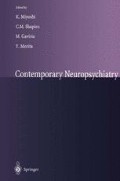Summary
On the basis of findings from family, twin, and adoption studies, heredity emerges as a major etiological factor in the pathogenesis of schizophrenia. Molecular genetic techniques (mainly genetic association and linkage studies) indicate that area 13q32 on chromosome 13 and, possibly, areas 6p24–22, 6q16–24, 8p, and 22q11–13, as well as the gene of serotonin 2A receptor, may be implicated in the pathogenesis of schizophrenia. As yet, however, no major genes have been identified; this is mainly because of the assumed heterogeneity of the disease, multigenic inheritance, reduced penetrance of genotype(s), and interplay between genetic and environmental vulnerability factors. Identification of genetically homogeneous patient subgroups and carriers of genes with reduced penetrance is based on “soft” neurological signs; deficits in auditory sensory gating and smooth pursuit eye movements; neuroanatomical abnormalities; deviant patterns of cerebral regional blood flow, functional MRI and brain lateralization; and biochemical indices of neurotransmitter abnormalities. The integration of molecular genetics with other fields of neuropsychiatry could provide new advances in our understanding of the interactions among the various genetic and environmental mechanisms leading to schizophrenia and allow the implementation of accurate genetic counseling and more appropriate interventions for the prevention and management of this devastating disease.
Access this chapter
Tax calculation will be finalised at checkout
Purchases are for personal use only
Preview
Unable to display preview. Download preview PDF.
References
Arolt V, Lencer R, Nolte A, et al (1996) Eye tracking dysfunction is a putative phenotypic susceptibility marker of schizophrenia and maps to a locus on chromosome 6p in families with multiple occurrence of the disease. Am J Med Genet 67:564–579
Berrettini WH (2000) Susceptibility loci for bipolar disorder: overlap with inherited vulnerability to schizophrenia. Biol Psychiatry 47:245–251
Blouin JL, Dombroski BA, Nath SK, et al (1998) Schizophrenia susceptibility loci on chromosomes 13q32 and 8p21. Nat Genet 20:70–73
Coon H, Plaetke R, Holik J, et al (1993) Use of a neurophysiological trait in linkage analysis of schizophrenia. Biol Psychiatry 34:277–289
Dikeos DG, Papadimitriou GN, Avramopoulos D, et al (1999) Association between the dopamine D3 receptor gene locus (DRD3) and unipolar affective disorder. Psychiatr Genet 9:189–195
Freedman R, Coon H, Mules-Worsley M, et al (1997) Linkage of a neurophysiological deficit in schizophrenia to a chromosome 15 locus. Proc Natl Acad Sci USA 94:587–592
Gottesman II (1991) Schizophrenia genesis. Freeman, New York
Jonsson EG, Nothen MM, Neidt H, et al (1999) Association between a promoter polymorphism in the dopamine D2 receptor gene and schizophrenia. Schizophr Res 40:31–36
Karayiorgou M, Gogos JA (1997) Dissecting the genetic complexity of schizophrenia. Mol Psychiatry 2:211–223
Kringlen E (1995) Twin studies in mental disorders. In: Mendlewicz J, Papadimitriou GN (eds) Genetics of mental disorders, part I. Theoretical aspects. Bailliere’s clinical psychiatry, international practice and research, vol 1. Tindall, London, pp 47–62
Lander E, Kruglyak L (1995) Genetic dissection of complex traits: guidelines for interpreting and reporting linkage results. Nat Genet 11:241–247
Okuyama Y, Ishiguro H, Toru M, Arimani T (1999) A genetic polymorphism in the promoter region of DRD4 associated with expression and schizophrenia. Biochem Biophys Res Commun 258:292–295
Pulver AE (2000) Search for schizophrenia susceptibility genes. Biol Psychiatry 47:221–230
Rietschel M, Krauss H, Muller DJ, et al (2000) Dopamine D3 receptor variant and tardive dyskinesia. Eur Arch Psychiatry Clin Neurosci 250:31–35
Risch N (1990) Linkage strategies for genetically complex traits. I. Multilocus models. Am J Hum Genet 46:222–228
Risch N, Merikangas K (1996) The future of genetic studies of complex human diseases.Science 273:1516–1517
Scharfetter J, Chaudhry HR, Hornik K, et al (1999) Dopamine D3 receptor gene polymorphism and response to clozapine in schizophrenic Pakastani patients. Eur Neuropsychopharmacol 10:17–20
Schulsinger F (1995) US-Denmark adoption studies. In: Mendlewicz J, Papadimitriou GN (eds) Genetics of mental disorders, part I. Theoretical aspects. Bailliere’s clinical psychiatry, international practice and research, vol 1. Tindall, London, pp 63–75
Spielman RS, McGinnis RE, Ewens WJ (1993) Transmission test for linkage disequilibrium: The insulin gene region and insulin-dependent diabetes mellitus (IDDM). Am J Hum Genet 52:506–516
Spitzer M (1997) A cognitive neuroscience view of schizophrenic thought disorder. Schizophr Bull 23:29–50
Stefanis CN (1990) On the concept of schizophrenia. In: Kales A, Stefanis CN, Talbott JA (eds) Recent advances in schizophrenia. Springer, New York
Stefanis CN, Dikeos DG, Papadimitriou GN (1995) Clinical strategies in genetic research. In: Mendlewicz J, Papadimitriou GN (eds) Genetics of mental disorders, part 1. Theoretical aspects. Bailliere’s clinical psychiatry, international practice and research, vol 1. Tindall, London, pp 1–18
Stefanis N, Frangou S, Yakeley J, et al (1999) Hippocampal volume reduction in schizophrenia: effects of genetic risk and pregnancy and birth complications. Biol Psychiatry 46:697–702
Toru M (1998) Biological research on schizophrenia. Psychiatry Clin Neurosci 52(suppl):S170–S172
Tsuang M (2000) Schizophrenia: genes and environment. Biol Psychiatry 47:210–220
Tu JB (1994) Theory and practice of pharmacogenetics. Am J Med Genet (Neuropsychiatr Genet) 54:391–397
Waldo MC, Adler LE, Leonard S, et al (2000) Familial transmission of risk factors in the first-degree relatives of schizophrenic people. Biol Psychiatry 47:231–239
Williams J, Spurlock G, McGuffin P, et al (1996) Association between schizophrenia and T102C polymorphism of the 5-hydroxytryptamine type 2a-receptor gene. European Multicentre Association Study of Schizophrenia (EMASS) Group. Lancet 347:1294–1296
Williams J, Spurlock G, Holmans P, et al (1998) A meta-analysis and transmission disequilibrium study of association between the dopamine D3 receptor gene and schizophrenia. Mol Psychiatry 3:141–149
Author information
Authors and Affiliations
Editor information
Editors and Affiliations
Rights and permissions
Copyright information
© 2001 Springer Japan
About this paper
Cite this paper
Dikeos, D.G. (2001). The Genetics of Schizophrenia. In: Miyoshi, K., Shapiro, C.M., Gaviria, M., Morita, Y. (eds) Contemporary Neuropsychiatry. Springer, Tokyo. https://doi.org/10.1007/978-4-431-67897-7_44
Download citation
DOI: https://doi.org/10.1007/978-4-431-67897-7_44
Publisher Name: Springer, Tokyo
Print ISBN: 978-4-431-67992-9
Online ISBN: 978-4-431-67897-7
eBook Packages: Springer Book Archive

